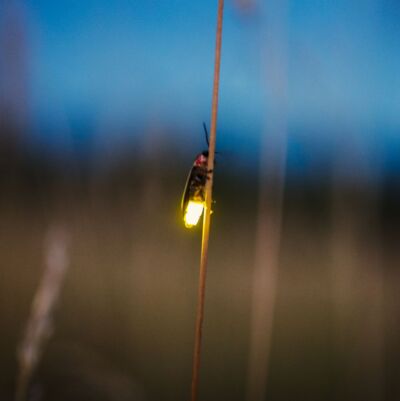Enchanting Fireflies
While not everyone is a fan of insects, there is one that seems to win the hearts of many. Fireflies enrich our lives by lighting up the night sky with their magical twinkles. Their enchanting light display sparks curiosity and captures our imaginations, but behind all this drama, there are hidden secrets of romance, deception, and death.
First off, fireflies, or lightning bugs, are not flies nor bugs – they are beetles. They belong to the family Lampyridae (which means to shine) and are best known for their ability to emit light. Like other beetles, they have a pair of hardened wing cases, called elytra, with their flying wings folded beneath them. The elytra open for liftoff like wing-doors on a car, freeing their secondary wings for flight.
With more than 2,000 species of fireflies worldwide (including 32 found in Canada), they are incredibly diverse, and many share the same habitat. In fact, there are probably multiple species in your yard.
The flashes are the firefly’s language of love. The twinkles you see are usually males looking for females. They flash a specific pattern while in flight, hoping a female will reply. If a female waiting in the grass or bushes likes what she sees, she responds back with a flash of her own. They will engage in this twinkling “conversation” until the male locates the female, and they mate. Each species has its own pattern of flashes (varying in colour, duration, and timing) – a code that lets individuals identify appropriate mates of the same species. By deciphering these patterns, you can determine how many species are present.

Photo credit: Jeremy Hogan, Getty Images
Fireflies have special “glow” organs under their abdomens that combine oxygen with a substance called luciferin to emit light. They can start or stop the glowing at any time by controlling how much oxygen is drawn in. Almost 100% of the energy from this chemical reaction is emitted as light with little heat loss, making it the most efficient light on earth. Despite their name, some adult fireflies lack the ability to glow, and these species find a mate by using chemical signals or pheromones.
After the adults have finished mating and laying eggs, they die, but the magic is not over. Once the eggs hatch, fireflies can spend up to two years in the larval stage before metamorphosing into adults. The armored, grub-like young, sometimes known as glowworms, also have the ability to glow and are found in leaf litter and decaying organic matter in moist meadows and forests, and around wetlands. At night, the ground can be seen lit up like twinkling Christmas lights.
The larvae are formidable predators, tracking down and consuming slugs, snails, and earthworms by using neurotoxins to immobilize their prey. Some adult fireflies don’t eat at all, but others feast on nectar and pollen, providing beneficial pollinating services to flowering plants. Both the adult and larva contain a bitter defensive chemical and use their light to warn their predators, such as birds, bats and frogs, that they are distasteful.
So, what about deception and death? Interestingly, the female of one group of fireflies, called Photuris, has earned the nickname femme fatales because she lures unsuspecting males of a smaller species to their death. By mimicking the flash patterns of the other firefly species, the female entices the male towards her, and he then becomes her dinner.
Sadly, firefly populations are now threatened in North America, due to light pollution and habitat loss. Outdoor lights confuse fireflies and prevent them from seeing each other’s flash patterns, leading to less reproduction. Turning off your lights at night in June and July during firefly season will ensure fireflies will continue to inspire and captivate us with their magical light displays.
Contact: Brenda Gallagher, Forestry Technician

